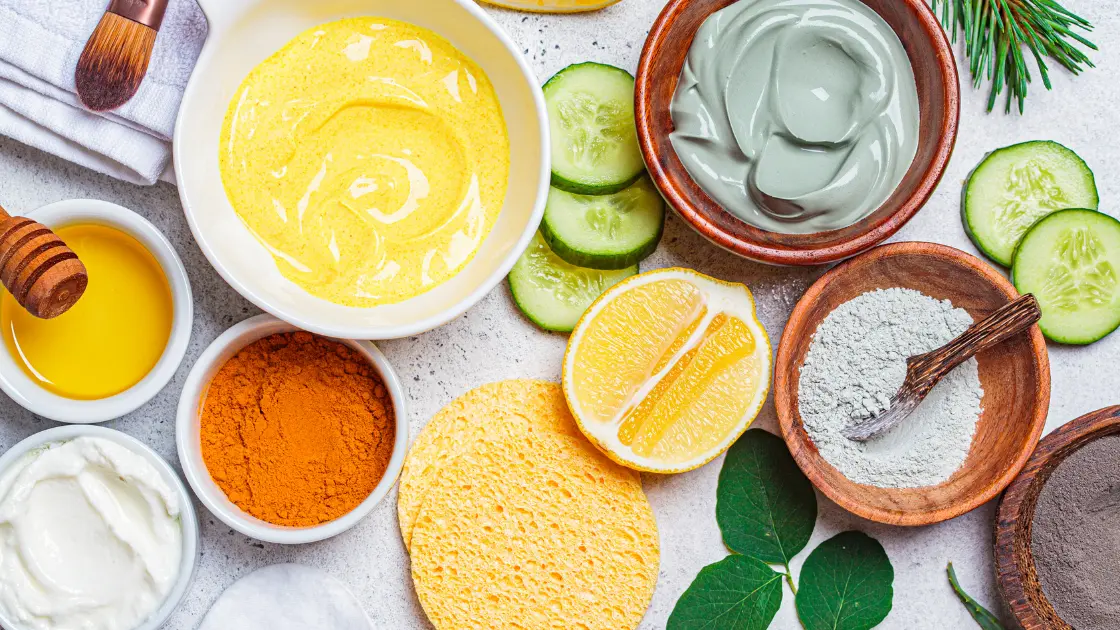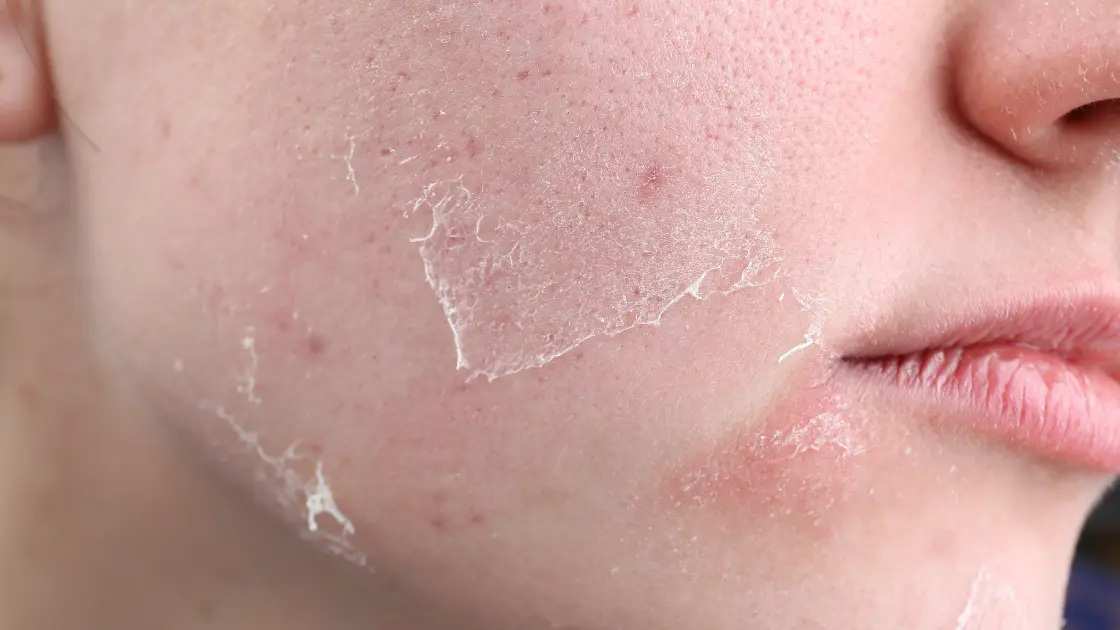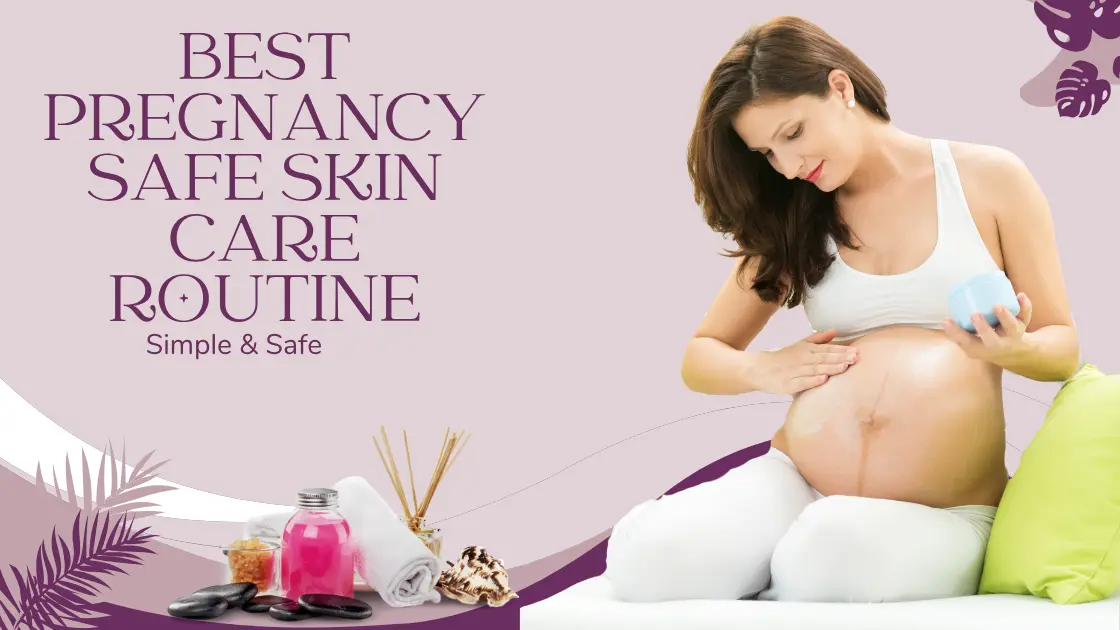The best pregnancy safe skincare routine is essential for protecting both your skin and your baby during these magical nine months. Pregnancy changes everything — your hormones, your energy, and yes, your skin. Whether it’s sudden acne breakouts, dryness, sensitivity, or that famous glow, your body is reacting to a new life growing inside. That’s why choosing a pregnancy safe skincare routine isn’t just about beauty — it’s about safety and comfort too.
In this guide, we’ll break down the best pregnancy safe skincare tips, product types, and full daily steps so you never feel lost about what’s safe or what works. Let’s build a routine that supports your glow, calms your skin, and gives your baby the safest start.
Table of Contents
- What to Avoid in Skincare During Pregnancy
- Building the Best Pregnancy Safe Skincare Routine Step-by-Step
- Evening Pregnancy Safe Skincare Routine
- Pregnancy Skin Concerns and Safe Solutions
- Best Pregnancy Safe Skincare Ingredients to Look For
- Safe Body Skincare Tips During Pregnancy
- Pregnancy Safe Skincare Routine by Skin Type
- Weekly Extras: Masks, Scrubs & Treatments That Are Safe During Pregnancy
- Common Mistakes to Avoid in a Pregnancy Safe Skincare Routine
- Frequently Asked Questions (FAQ) About Pregnancy Safe Skincare
- Conclusion: Build Your Best Pregnancy Safe Skincare Routine with Confidence
What to Avoid in Skincare During Pregnancy
Not all skincare is safe when you’re expecting. Some common ingredients can penetrate your skin and potentially affect your baby. Knowing what to avoid is just as important as knowing what to use.
Harmful Ingredients to Watch Out For
Here’s a quick list of ingredients you should eliminate from your routine immediately:
- Retinoids (Vitamin A derivatives) – Found in anti-aging and acne products; linked to birth defects.
- Salicylic Acid (high concentrations) – Often used for exfoliation or acne; oral forms have been associated with pregnancy risks.
- Hydroquinone – A skin-lightening agent; absorbs into the body at higher rates.
- Formaldehyde and formaldehyde releasers – Used in some nail products and preservatives; toxic and possibly cancer-causing.
- Phthalates – Found in synthetic fragrances; known endocrine disruptors.
- Chemical sunscreens (like oxybenzone) – May disrupt hormones and affect fetal development.
Safe Doesn’t Always Mean Natural
Natural products aren’t automatically safe. Some essential oils like rosemary, clary sage, and jasmine can trigger uterine contractions or sensitivity. Always check with your healthcare provider before using new skincare.
Building the Best Pregnancy Safe Skincare Routine Step-by-Step

Creating the best pregnancy safe skincare routine means building a ritual that protects, nourishes, and calms your skin — all while keeping your baby safe. Let’s proceed one step at a time.
Morning Pregnancy Safe Skincare Routine
Hydration, protection, and making sure your skin is prepared for the day are your top priorities when it comes to your morning routine.
Step 1 – Gentle Cleanser
Make use of a non-foaming, fragrance-free cleanser. Seek out products that have:
- Glycerin hydrates the body gently.
- Surfactants derived from coconuts are gentle cleaners.
- Aloe vera cools and calms the skin.
🧴 Recommended: Vanicream Gentle Facial Cleanser or CeraVe Hydrating Cleanser.
Step 2 – Hydrating Toner (Optional)
If your skin is feeling dry, a hydrating toner can restore pH balance and prep your skin for serum.
Look for:
- Rose water (pure, no added fragrance)
- Chamomile extract
- Hyaluronic acid
Avoid toners with alcohol or strong botanical oils.
Step 3 – Pregnancy Safe Serum
Target your specific skin concerns with a pregnancy safe skincare serum. Try:
- Vitamin C (L-Ascorbic Acid) – for brightness
- Niacinamide – reduces redness and balances oil
- Peptides – help firm and restore
🧴 Recommended: The Ordinary Niacinamide 10% + Zinc 1% or Mad Hippie Vitamin C Serum.
Step 4 – Lightweight Moisturizer
Choose a non-comedogenic, fragrance-free moisturizer rich in:
- Ceramides
- Squalane
- Shea butter (in moderation)
🧴 Recommended: La Roche-Posay Toleriane Double Repair or Biossance Squalane + Probiotic Gel Moisturizer.
Step 5 – Mineral-Based Sunscreen
This is the most important step. Choose zinc oxide or titanium dioxide-based SPF 30+.
🧴 Recommended: EltaMD UV Pure Broad-Spectrum SPF 47 or Blue Lizard Sensitive SPF 30.
Evening Pregnancy Safe Skincare Routine
Your night routine is all about cleansing the day away and letting your skin heal while you sleep. Think moisture, calm, and gentle renewal — using only pregnancy safe skincare products.
Step 1 – Double Cleanse (If Wearing Makeup or SPF)
If you wore makeup or sunscreen, start with an oil-based cleanser (pregnancy-safe) to melt it off, then follow with your regular cleanser.
Look for: squalane, sunflower oil, or jojoba oil-based formulas
- 🧴 Recommended: Burt’s Bees Cleansing Oil or Cocokind Facial Cleansing Oil
Then, cleanse again using your morning gentle cleanser to remove any residue.
Step 2 – Hydrating Serum or Treatment
Evening is a good time for deeper treatment. Use:
- Niacinamide – reduces pores and inflammation
- Azelaic acid (10% or less) – safe for brightening and acne
- Bakuchiol – a gentle, pregnancy safe retinol alternative
🧴 Recommended: Paula’s Choice 10% Azelaic Acid Booster or Herbivore Bakuchiol Serum
Step 3 – Rich Night Moisturizer
Hydrate deeply with a thicker, calming cream at night.
Look for:
- Ceramides
- Shea butter
- Oat extract
- Colloidal oatmeal
🧴 Recommended: Aveeno Calm + Restore Oat Gel Moisturizer or CeraVe PM Facial Moisturizing Lotion
Optional: Facial Oil (if needed)
If your skin is extra dry or flaky, layer a drop of rosehip seed oil or argan oil over your moisturizer. Avoid essential oils like clary sage or rosemary.
Pregnancy Skin Concerns and Safe Solutions

Your skin may still encounter new difficulties even with the best pregnancy-safe skincare regimen. Unexpected changes may be brought on by hormonal changes during pregnancy, but they can be safely and successfully managed with the correct strategy.
Pregnancy Acne
What it is: Hormonal breakouts, often on the jawline or cheeks, caused by increased oil production.
Safe solutions:
- Use niacinamide to control oil and inflammation
- Try azelaic acid to unclog pores and brighten
- Cleanse twice daily with a mild, non-stripping formula
🧴 Avoid: Salicylic acid over 2%, benzoyl peroxide, and retinoids
Melasma (Pregnancy Mask)
What it is: Brown or gray patches on the face, especially on the cheeks and forehead.
Safe solutions:
- Apply broad-spectrum mineral sunscreen daily
- Use vitamin C serum for brightening
- Add azelaic acid at night for pigment control
🧴 Avoid: Hydroquinone, retinoids, and chemical exfoliants
Dryness and Itchiness
What it is: Common in the second and third trimester due to stretching skin and hormonal dehydration.
Safe solutions:
- Use a rich moisturizer with ceramides and squalane
- Apply colloidal oatmeal for calming and itch relief
- Use a humidifier in dry climates
Sensitivity and Redness
What it is: Skin becomes more prone to flushing and more reactive.
Solutions that are safe:
- Make the switch to hypoallergenic, fragrance-free products.
- Add green tea extract, chamomile, or aloe vera.
- Don’t exfoliate too frequently.
Best Pregnancy Safe Skincare Ingredients to Look For

Choosing the best pregnancy safe skincare routine means knowing what ingredients are not just safe — but also effective. These gentle yet powerful ingredients will help you manage breakouts, dryness, pigmentation, and sensitivity during pregnancy.
Hydrating & Moisturizing Ingredients
Hyaluronic Acid
Draws moisture into the skin without clogging pores. It’s lightweight and deeply hydrating — ideal for dry, sensitive pregnancy skin.
Glycerin
Another excellent humectant, glycerin helps lock in moisture and keeps your skin barrier strong.
Squalane
A natural oil that mimics your skin’s sebum. Great for balancing oil and restoring softness without causing breakouts.
Brightening & Repairing Ingredients
Vitamin C (L-Ascorbic Acid)
Fights dullness and pigmentation, supports collagen, and is safe when used in moderation.
Azelaic Acid
One of the most dermatologist-recommended ingredients for pregnancy safe skincare. Treats acne, reduces redness, and evens skin tone.
Niacinamide
Vitamin B3 soothes inflammation, strengthens the skin barrier, and minimizes pores.
Anti-Aging Alternatives
Bakuchiol
A gentle, plant-based retinol alternative that offers similar anti-aging benefits — without any of the risks.
Peptides
Support collagen production and help firm and plump the skin over time.
Soothing Botanicals
- Chamomile Extract – Calms irritation
- Calendula – Reduces redness
- Aloe Vera – Cools and heals
⚠️ Always ensure botanicals are pure, essential-oil free, and from pregnancy-approved formulations.
Safe Body Skincare Tips During Pregnancy
While your face often gets the spotlight, your pregnancy safe skincare routine should cover your entire body. Your belly, breasts, thighs, and back all go through changes that deserve care, hydration, and protection.
Stretch Mark Prevention and Treatment
Rapid skin stretching results in stretch marks. With regular care, you can lessen their appearance even though they are normal and natural.
Key Ingredients to Use
- Shea butter: softens and deeply nourishes skin.
- Cocoa butter: Enhances elasticity
- Vitamin E: Promotes smooth texture and healing
- Centella Asiatica, also known as Cica, increases collagen and reduces irritation.
🧴 Recommended: Earth Mama Belly Butter, Bio-Oil (fragrance-free), or Burt’s Bees Mama Bee Belly Butter
Body Acne During Pregnancy
Hormonal changes may cause breakouts on the back, chest, or shoulders.
Safe Tips:
- Use fragrance-free body wash with mild exfoliating ingredients like lactic acid
- Avoid pore-clogging lotions — go for non-comedogenic moisturizers
- Wear breathable cotton fabrics
🧴 Recommended: Cetaphil Gentle Skin Cleanser, Eucerin Roughness Relief
Dealing with Itchy Belly & Dry Patches
Stretching skin often leads to irritation or dryness.
Solutions:
- Apply colloidal oatmeal creams or coconut oil
- Avoid hot showers; opt for lukewarm water
- Moisturize twice daily — especially post-shower
🧴 Recommended: Aveeno Skin Relief Moisturizing Lotion, Pipette Belly Oil
Pregnancy Safe Skincare Routine by Skin Type
Everybody’s skin reacts differently to pregnancy. Regardless of whether you have oily, dry, or sensitive skin, your pregnancy safe skincare routine should be customized to your skin’s particular needs at this special time.
For Oily or Acne-Prone Skin
Hormonal fluctuations often lead to increased oil production and breakouts.
Key Tips:
- Use a gel-based cleanser with niacinamide or green tea
- Stick to lightweight, oil-free moisturizers
- Add a pregnancy safe exfoliant like azelaic acid (2–3x/week)
🧴 Recommended:
- Cleanser: Youth to the People Superfood Cleanser
- Moisturizer: Neutrogena Hydro Boost (Fragrance-Free)
- Treatment: The Ordinary Niacinamide 10% + Zinc
For Dry or Dehydrated Skin
Our skin may feel tight, flaky, or itchy, especially in the winter months.
Key Tips:
- nstead of using a foaming cleanser, use one that is creamy.
- Use a toner or hydrating essence.
- To keep moisture in, use hyaluronic acid and squalane
🧴 Recommended:
- Cleanser: CeraVe Hydrating Facial Cleanser
- Serum: Vichy Mineral 89
- Moisturizer: First Aid Beauty Ultra Repair Cream
For Reactive or Sensitive Skin
Pregnancy can cause more sensitivity to scents, active ingredients, and even the weather.
Key Tips:
- Steer clear of harsh exfoliants and essential oils.
- Use products with few ingredients and no fragrance.
- Seek out soothing components such as colloidal oatmeal and aloe vera.
🧴 Recommended:
- Cleanser: Vanicream Gentle Facial Cleanser
- Moisturizer: La Roche-Posay Toleriane Sensitive
- Treatment: Avene Thermal Spring Water Spray
Weekly Extras: Masks, Scrubs & Treatments That Are Safe During Pregnancy
Once or twice a week, your skin deserves a little extra love. With the right products, you can safely exfoliate, detox, or boost hydration without exposing your body to harmful ingredients. These additions will make your best pregnancy safe skincare routine feel like a mini spa day — just what you need during this special time.
Safe Exfoliation Options
Gentle exfoliation helps remove dead skin, unclog pores, and boost cell turnover. But during pregnancy, avoid harsh acids and scrubs.
What to Use:
- Lactic Acid (under 10%) – a milder AHA safe for pregnancy
- PHA (Polyhydroxy acids) – even gentler than AHAs and deeply hydrating
- Soft jojoba bead scrubs – physical exfoliant that won’t scratch
🧴 Recommended:
- The Inkey List Lactic Acid Serum
- Naturium PHA Topical Acid
- Acure Brightening Facial Scrub (walnut-free)
🧴 Avoid: Glycolic acid, salicylic acid, and aggressive microdermabrasion scrubs
Face Masks That Calm and Hydrate
Masks can restore balance and soothe inflammation — just stick to pregnancy safe skincare ingredients.
What to Use:
- Clay masks with kaolin – gently detoxifies without overdrying
- Hydrating masks with hyaluronic acid or aloe
- Sheet masks with niacinamide or chamomile
🧴 Recommended:
- Honest Beauty 3-in-1 Detox Mud Mask
- Aveeno Calm + Restore Oat Gel Mask
- Burt’s Bees Hydrating Sheet Mask
DIY Pregnancy Safe Skincare Treatments
Safe and efficient skincare solutions can be made with basic kitchen ingredients:
- A mask made of oatmeal and honey is excellent for relieving irritation.
- Banana mash combined with yogurt hydrates and softens
- Slices of cucumber can cool the skin and lessen puffiness.
Common Mistakes to Avoid in a Pregnancy Safe Skincare Routine

Even when you’re trying your best, it’s easy to slip into habits that may compromise your pregnancy safe skincare efforts. Here’s a list of pitfalls to avoid so your routine stays both effective and baby-safe.
1. Assuming “Natural” Always Means Safe
Not all natural products are safe during pregnancy. Essential oils like clary sage, rosemary, and jasmine can cause uterine contractions or irritation. Some plant extracts haven’t been tested for fetal safety.
✅ Always choose pregnancy-safe, dermatologist-approved products — not just “clean” or “organic” labels.
2. Skipping Sunscreen
UV exposure can make melasma and pigmentation worse — especially during pregnancy. Many moms-to-be avoid SPF due to fear of chemicals.
✅ Use a mineral sunscreen with zinc oxide or titanium dioxide every day — even indoors or on cloudy days.
3. Over-Exfoliating
Exfoliating too often (or using harsh scrubs/acids) can damage your skin barrier and worsen sensitivity.
✅ Limit exfoliation to 1–2 times per week with lactic acid or PHA. Avoid glycolic acid or physical scrubs with rough particles.
4. Ignoring Patch Testing
Pregnancy can trigger new allergies or sensitivities — even to products you used before.
✅ Always patch test new skincare on your jawline or inner arm before full application.
5. Using Too Many Products at Once
Layering 5–7 products might seem trendy, but it can overwhelm hormonal skin.
✅ Stick to a simple, focused routine: gentle cleanser → targeted serum → moisturizer → sunscreen (AM) or treatment (PM).
Frequently Asked Questions (FAQ) About Pregnancy Safe Skincare
These common questions will help clarify the most confusing parts of building the best pregnancy safe skincare routine, especially for first-time moms.
Is it safe to use salicylic acid during pregnancy?
Yes, in low concentrations (under 2%), salicylic acid is generally considered safe in wash-off products like cleansers. However, high-dose leave-on treatments and peels should be avoided. Consider safer alternatives like azelaic acid or lactic acid.
Can I use retinol or retinoids while pregnant?
No. Retinoids — including retinol, tretinoin, adapalene, and isotretinoin — are not safe during pregnancy. They are linked to birth defects. Use bakuchiol, a natural alternative with similar anti-aging benefits.
What is the safest sunscreen to use during pregnancy?
Use mineral-based sunscreens with zinc oxide or titanium dioxide. They sit on top of the skin and reflect UV rays, posing no risk to the baby. Look for fragrance-free, broad-spectrum SPF 30+ formulas.
How can I treat dark spots or melasma during pregnancy?
For pregnancy-safe treatment of melasma:
- Use Vitamin C in the morning
- Apply azelaic acid at night
- Wear SPF daily
- Avoid hydroquinone or chemical peels
What’s the best pregnancy safe skincare routine for glowing skin?
The best pregnancy safe skincare routine includes:
- Gentle cleanser
- Hydrating serum with niacinamide or Vitamin C
- Moisturizer with ceramides or squalane
- Mineral sunscreen in the morning
- Azelaic acid or bakuchiol at night
Adjust based on your skin type — oily, dry, or sensitive.
Are essential oils safe to use during pregnancy?
Some are safe in very small doses, like lavender or chamomile, but others like clary sage, rosemary, and peppermint should be avoided. When in doubt, skip essential oils or consult your OB-GYN.
When should I start using stretch mark creams?
Start as early as the first trimester. Daily use of shea butter, vitamin E, or centella can help improve skin elasticity and minimize stretch marks. Massage creams onto your belly, breasts, hips, and thighs.
Can I continue using my regular skincare products?
Not always. You’ll need to check ingredient labels and eliminate anything with retinoids, salicylic acid, formaldehyde, parabens, or chemical sunscreens. Transition to a dedicated pregnancy safe skincare routine for peace of mind.
Conclusion: Build Your Best Pregnancy Safe Skincare Routine with Confidence
Your skin deserves just as much care as your growing baby — and building the best pregnancy safe skincare routine is one of the kindest gifts you can give yourself during this journey.
Pregnancy may come with hormonal chaos, acne, dryness, and sensitivity, but you don’t have to suffer through it. With the right pregnancy safe skincare routine, you can glow safely and confidently from your first trimester to postpartum recovery.
Stay tuned with Pregnancy Must and have a safe pregnancy journey.
Explore more-
- Pregnancy Safe Sunscreen: Protect Your Skin While Expecting
- Stunning Maternity Photoshoot Dress Styles to Try
